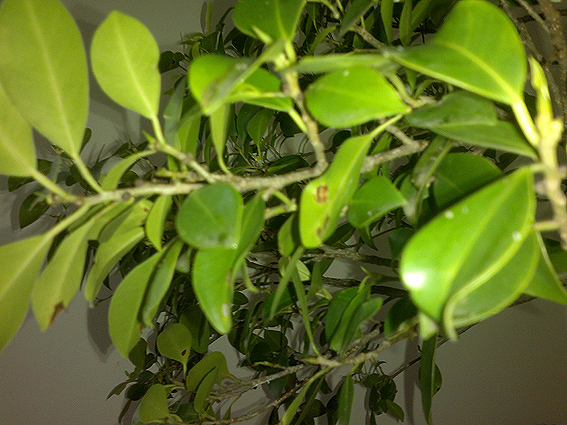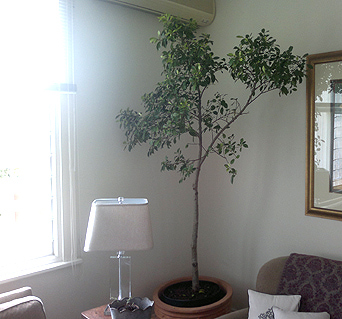Question
 ficus brown spots
ficus brown spots  ficus
ficus
Recently bought a tall spindly ficus from a nursery where it was kept outside packed closely with other trees, not only ficus, and didnt get full sun. Overhead tall trees.
Liked it because of its shape although I could see that it wasnt happy. Brown spots on some of the leaves and some leaves yellow and falling. Also some leaves had a sticky residue, but no scale that `i could see.
We have put it inside near a window where it gets filtered light (blinds) and some direct light (blinds raised), but no direct sun.
We haven't repotted it. Pot is 450mm across and the plant is about 2m high.
I put some organic potting soil over the semi exposed roots and fed with ....... also watered with some epsom salts. I noticed a bout three beetles burrowing in the soil and killed them, but also found a rubbery slippery spongy substance growing around the underside of the semi-exposed roots at the top of the pot. Irregular shapeI dug around with my fingers and found more. `pulled out as much as `i could find, and put more soil in the pot and dug it in and pressed down over the roots. watered and fed and hoped like hell I hadn't added to the tree's woes. No idea if the beetles and fungus-like-stuff were friend or foe - but went with my gut feeling which I hope was accurate?
Another thing which worries me is the tree is heavy in its plastic pot and because it is on a carpet we have put the plastic pot AND DRIP TRAY in a bigger terracotta pot - which is tricky because `i cant lift it to see if I may be over watering. (nearly killed another ficus which we have had for 23 years, for the same reason) We have put it out on the deck in direct sun and fed it and it is well drained now, and doing very well, but all the growth is on t=one side - the other side I killed effectively with over watering because `I couldn't see how much I was giving it. How much water and how often would you advise ??
We live in South Africa so there is a lot of sunshine and the summers are very humid and hot at sea level.
Here are the questions I so hope you can answer for me:
what treatment for sticky leaves?
why are the leaves yellowing and falling at an alarming rate, although I can see new leaf growth, which gives me hope.
what are the brown spots. nurseryman seemed to think that a ficus is prone to brown spots and the plant probably just needed feeding?
Thanks so much for listening. I feel an affinity with my strange collection of plants and funny as it sounds - feel they respond to my chattering and encouragingly stroking them....
Anita Weedon
AnswerHi Anita,
In my professional experience, sound knowledge goes a lot farther than affinity in caring for plants.
Your Ficus tree is responding to a major change in environment as you moved it from outside where the sunlight is very intense to a location inside where it does not get enough light to survive over the long-term. It is the dramatic reduction in light that is the primary cause of the leaf discoloration, including the spots, and leaf drop.
Move your tree to an indoor location directly in front of a window that is uncovered throughout the daylight hours. It will take 3 to 6 months for your tree to acclimate to its new environment. If you relocate it, it will be forced to re-acclimate again. Moving a plant back and forth between indoors and outdoors is a bad idea because it continually stresses the plant by forcing it to acclimate. During the acclimation period, leaves will continue to discolor and drop but at a reduced rate. New leaves adapted to the new environment will emerge and remain healthy. Stems that are bare or mostly bare should be pruned back.
Lop-sided growth is not caused by over watering. It is a result of getting light from one side only. Be sure to rotate your tree a quarter turn weekly so all sides get equal exposure to light.
It is possible that the stickiness, called honeydew, came from scale insects on another nearby tree. But I am not sure you are able to identify scale insects in their juvenile stage when they are translucent. Therefore, I recommend that you mix a solution of 5 parts water, 1 part isopropyl alcohol and a squirt of liquid dish soap. Thoroughly spray all leaf and stem surfaces until all are dripping wet. This is a messy process, but thoroughness is the key to effectiveness.
Plant food is only for healthy, vigorously growing plants. Lack of nutrients is NOT the cause of the leaf spotting. Epsom salts are a source of magnesium. Unless you have had a soil analysis done by a lab, there is no reason to think that your tree is deficient in magnesium. I recommend you cease using epsom for your plants and reserve it for your bath.
Your tree is a bit overpotted. Adding soil to it was not a good idea. I suspect the spongy material you found around the surface roots was some kind of moss-like material that the nursery mistakenly added to cover the exposed roots. Exposed roots are not a problem. Once exposed, the roots develop a bark like structure that is then vulnerable to rot if covered with damp soil. Remove the soil you added to the surface because this soil will also make it more difficult for you to properly gauge when to water. If the appearance of exposed roots bothers your aesthetic sense, then cover them with Spanish moss.
You do need to be able to determine if excess water is accumulating at the bottom of the pot. That means you should be using a terra-cotta pot that is one size larger so you can see to its bottom. After removing the excess soil you added, allow the top inch of soil to dry before watering enough that it reaches that level of dryness again in about one week. Adjust the quantity of water used to obtain this one-week goal.
It is good that you care about your plants and enjoy them. However, the best of intentions and good feelings will not overcome poor horticultural practices based on incorrect or incomplete information. I hope you have found my information helpful.
I have written articles on indoor plant pests, fetilizer and on Ficus care that I will email for free to you (or anyone else) who emails a request to me at
[email protected].
Please let me know if any of this is unclear or if you have any additional questions.
If this information has been helpful, please click the Rate Volunteer bar below and enter a rating and nomination for me. I am a volunteer on this site so Ratings are the only compensation I receive for answering plant questions.
Need more information? Visit my website at:
A link to HorticulturalHelp.com
or email me at
[email protected] or call me at 917-887-8601 (EST)
Regards,
Will Creed, Interior Landscaper
Horticultural Help, NYC
Visit my website at: A link to HorticulturalHelp.com







